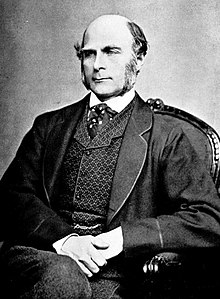Sedimentation hypothesis
The sedimentation hypothesis , also lexical hypothesis or lexical approach , describes the assumption in psychology that all important personality traits are colloquially represented by adjectives of the respective language.
It is assumed that human languages have developed special words over time for all personal characteristics that are or were significant, interesting or useful. With the importance of individual personality differences, the probability that the language produced a separate word also increased. The collection of terms of a language area with which individual differences can be described should cover the area of the relevant individual differences.
It is one of the most important and widely used scientific theories in differential and personality psychology .
Among other things, the Big Five personality traits were obtained from a lexical analysis. With the help of statistical methods, psychologists have determined the decisive dimensions from thousands of adjectives used to designate personality. The concept also works with children and in other cultures.
Early guess
The sedimentation hypothesis was first formulated in part by Francis Galton (1884).
"I tried to gain an idea of the number of the more conspicuous aspects of the character by counting in an appropriate dictionary the words used to express them ... I examined many pages of its index here and there as samples of the whole, and estimated that it contained fully one thousand words expressive of character, each of which has a separate shade of meaning, while each shares a large part of its meaning with some of the rest. "
Investigations
Beginning (Germanic languages)
Justified by the history of science in psychology, the first investigations into Galton's considerations were carried out in the Anglo-American area, and accordingly on Germanic languages .
- Allport & Odbert (1936)
The first systematic compilation of initial lexical data was made by Gordon Allport and Henry Sebastian Odbert (1936), who searched the approximately 550,000 words in Webster's New International Dictionary from 1925 for adjectives, participles, and nouns that denoted personality dispositions.
Even after excluding nouns that corresponded to identical adjectives (e.g. fearfulness - fearful) and dialect variants, the list still consisted of 17,953 words, including many rare words that only a few English speakers can understand. The resulting list was divided into 4 categories:
- Generalized and personal dispositions - consistent and stable ways of adapting a person to their environment (e.g., sociable, aggressive, fearful - 4,504 terms)
- States, moods and activities (e.g. happy, sad, enthusiastic - 4,541 terms)
- Highly evaluative assessments of personal reputation (e.g. excellent, valuable, average - 5,226 terms)
- Physical and non-assignable characteristics (3,682 terms)
Various reduction methods are used on this list to obtain input data for factor analyzes .
- Cattell (1943)
Raymond Bernard Cattell started with the terms of the first category (plus 100 of the second category) and reduced them in several steps to 35 bipolar clusters (see cluster analysis ).
- Norman (1967)
Warren T. Norman reduced Allport and Odbert's list to 2,800 more common adjectives, excluding health-related terms (e.g. sickly) and highly evaluative terms (e.g. excellent, malicious).
- Goldberg (1990)
Lewis Goldberg, in turn, expanded and reduced the list in several steps of classification and assessment by students to 339 adjectives, which were classified into 100 groups of almost synonymous words.
- Angleitner & Ostendorf (1990)
For the German-speaking area, Angleitner et al. True German lexicon based on adjectives that describe personality traits. 5,092 adjectives were found and ultimately a five-factor structure resulted for the self-assessments and those of acquaintances, which largely corresponded to the Anglo-American »Big Five«.
Non Germanic languages and later investigations
- Chinese (Yang & Bond, 1990)
- Czech (Hrebickova & Ostendorf, 1995)
- Hebrew (Almagor et al., 1995)
- Hungarian (Szirmak & DeRaad, 1994)
- Italian (Di Blas & Forzi; Caprara & Perugini, 1998)
- Polish (Szarota, 1995)
- Russian (Shmelyov & Pokhilko, 1993)
- Turkish (Somer & Goldberg, 1999)
Similar concepts
The philosophy of normal language uses a similar approach : Through a detailed analysis of the everyday use of the language, knowledge can be gained.
- Phenomenological Psychology
Johannes Linschoten puts it: “I feel a bit cross.” The expression is a frozen meaning, a sediment and has received doxic value in its sedimentation [...] The danger that threatens psychology is this dogmatization of the doxic self-evident.
In the key work of social constructivism, written by Peter L. Berger and Thomas Luckmann (1966), one speaks of “sediments of knowledge and meaning”.
criticism
Although the lexical approach is widely used in personality studies, it is not without criticism.
- Many properties of psychological importance are too complex to be represented in individual words of everyday language. Sometimes an extensive text is required in order to precisely grasp and reflect on a certain character trait.
- There are lexical ambiguities ( homographs ) that are not always used in the correct context.
- There are languages that do not allow lexical analysis because there are no written traditions.
- Terms that describe personality change over time and differ in dialects, languages and cultures.
literature
- Wolfgang Müskens: Sediments of self-description: The lexical approach of personality research . Publishing house for science and research; Edition: 1st edition (2001). ISBN 3-897-00314-7 .
Individual evidence
- ↑ Jens B. Asendorpf: Psychology of Personality . Springer Berlin Heidelberg; Edition: 4th, revised. u. updated edition (August 21, 2007). ISBN 354071684X , page 478
- ↑ Jens B. Asendorpf: Psychology of Personality . Springer Berlin Heidelberg; Edition: 4th, revised. u. updated edition (August 21, 2007). ISBN 354071684X , page 154
- ↑ Galton 1884 book excerpt (PDF file; 450 kB)
- ^ Allport, G. & Odbert, H. (1936). Trait names: A psycho-lexical study. Psychological Monographs, Whole No. 211.
- ^ Cattell, RB (1943). "The description of personality: Basic traits resolved into clusters." Journal of Abnormal and Social Psychology, 1943, 38, 476-506
- ^ Warren T. Norman: 2800 personality trait descriptors: Normative operating characteristics for a university population . University of Michigan, Dept. of Psychology, 1967
- ^ Goldberg, LR (1990). "An alternative" description of personality ": The big-five factor structure". Journal of Personality and Social Psychology 59 (6): 1216-1229
- ↑ Angleitner, A. Ostendorf, F. & John, OP (1990). Towards a taxonomy of personality descriptors in German: A psycho-lexical study. European Journal of Personality, 4 (2), 89-118.
- ↑ Johannes Linschoten (author): On the way to a phenomenological psychology: The psychology of William James (phenomenological-psychological research) . De Gruyter (July 1961). ISBN 3110032406 , page 82
Web links
- The Lexical Hypothesis and the Lexical Approach - Eric Klopp: Article on the basics of the lexical hypothesis

